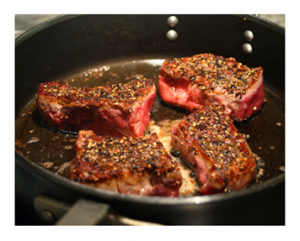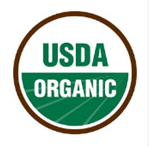I love a good steak. A petite filet with a glass of Cabernet or Pinot Noir. Nicely charred on the outside and rosy on the inside. Seared on high, covered in fresh ground pepper, add a dollop of dijon mustard, and garnish with a sprig of rosemary.
I certainly appreciate both!
I’m a meat-eater. And not only steak au poivre. I love beef, though admittedly the word itself reminds me not only of my mother’s (exceptional) beef stew during the long, cold winters of my childhood, but “Beefcake.”
Do you know the expression I mean? A hunky guy? And then there’s the delicious South Park Sketch called Beefcake.
Screechy voice and all, our little character is sucked in by an ad on television for a product to beef him up. In addition to enjoying the taste of meat dishes, have we forgotten the good effects of B vitamins and iron? Shouldn’t we pay attention, especially if we’re under stress?
I may not be looking to beef up my biceps, but I want those vitamins and I love my meat!
Nutritional Value in Meat Products
Don’t take my word for it. I’m not a nutritionist. But I have run low on iron at various points in life, and meat (along with black strap molasses and a glass of red wine a day) were among the recommendations that came from my physician.
Would you like more information on why meat is good for many of us, as long as we are choosing cuts wisely and not overdoing it?
 While searching out sources on the nutritional value of meat products, I found this helpful site, Self Nutrition Data. It goes beyond the cursory mentions we might expect. In other words, if you’re willing to take a few minutes to look (as I did), you’ll see more than calories, carbs, vitamins and minerals – but a break-down that offers explanations of other impacts (for instance whether or not a food offers anti-inflammatory effects), not to mention links and options for recipes.
While searching out sources on the nutritional value of meat products, I found this helpful site, Self Nutrition Data. It goes beyond the cursory mentions we might expect. In other words, if you’re willing to take a few minutes to look (as I did), you’ll see more than calories, carbs, vitamins and minerals – but a break-down that offers explanations of other impacts (for instance whether or not a food offers anti-inflammatory effects), not to mention links and options for recipes.
As I read the meat data, using a single serving of cooked meat as an example, I see the pros – high in B-12, in iron, in protein, and positive on the anti-inflammatory scale; I also see the cons – high in cholesterol.
For me personally, cholesterol isn’t a problem. So I’m more comfortable than ever with my two servings per week of red meat. Perhaps I ought to consider occasionally adding a third.
Carnivorous Delights
I may miss my mother’s beef stew not to mention her pot roast, but my tasty and affordable meat roster includes that steak au poivre I mentioned, along with small grass-fed burgers which I typically serve with a spinach salad and whatever veggies I have in the house. Or, I put the burger on a whole wheat bun loaded up with all the usual good stuff – careful to keep it healthy.
I have a few other beefy recipes in my coffers, but those are for other days, and hearty soups are more the norm around here not only for affordability and easy preparation, but because we adore veggies and soup is comfort food – any time of the year.
But when it isn’t soup on the menu?
It’s fish, chicken, or that weekly steak or burger.
 The curious thing to me at this point is that I no longer spring for a Big Mac or other “junk food” versions of mystery meat. I won’t say never, but it’s rare. I’ve lost my taste for them entirely, helped along by the fact that I’m likely forking over as much money for that Big Mac and fries as I could spend on a beautiful piece of grass-fed, hormone free ground beef.
The curious thing to me at this point is that I no longer spring for a Big Mac or other “junk food” versions of mystery meat. I won’t say never, but it’s rare. I’ve lost my taste for them entirely, helped along by the fact that I’m likely forking over as much money for that Big Mac and fries as I could spend on a beautiful piece of grass-fed, hormone free ground beef.
And that brings me to another terrific resource for health information, and some critical meat and poultry labeling distinctions we all ought to understand.
Meat and Poultry Labeling, Consumer Reports on Health
A recent article in Consumer Reports on Health, December 2012, “A Guide to the Meat Market,” features a guide to the various types of meat labels. The article specifically deals with the confusing realm of claims and certifications – some of which make for misleading marketing, and the rest, a fair amount of confusion.
 Please note that Consumer Reports on Health is available via subscription only, so I’m summarizing a few key points from my print copy which I borrowed from a friend, and now read regularly. It’s a publication I strongly recommend.
Please note that Consumer Reports on Health is available via subscription only, so I’m summarizing a few key points from my print copy which I borrowed from a friend, and now read regularly. It’s a publication I strongly recommend.
Here are a few nuggets you may find helpful.
- The most optimal labels on meat products are the following: American Heart Association (check mark); USDA Organic; (American) Grass-fed.
- You will find the “extra lean” AHA check mark on a variety of turkey products, with extra lean the better option of course, if at all possible.
- Grass-fed beef contains linoleic acid which may possibly improve the immune system.
- The American Grassfed Association has a seal (as does the AHA), and is considered the “gold standard” for the grass-fed claim.
- Grass-fed does not address the issue of antibiotics, hormones or pesticides.
- The USDA (U. S. Department of Agriculture) “Organic” label addresses issues of antibiotics and hormones. Look for the USDA Organic label on meat and poultry.
- Re USDA Organic, according to the Consumer Reports for Health article:
[USDA Organic}… means that the animals were not given antibiotics; growth hormones; feed that contained animal byproducts, manure, synthetic fertilizers, or sewage sludge; they were not genetically engineered; and the meat was not irradiated to eliminate bacteria.
Yikes!
 The article contains a great deal more information, clearly explained, including the fact that the following claims are typically misleading: “natural,” “no hormones,” and “no nitrates.”
The article contains a great deal more information, clearly explained, including the fact that the following claims are typically misleading: “natural,” “no hormones,” and “no nitrates.”
Healthy Eating
The net of “natural,” “no hormones,” and “no nitrates” as I understand the terms is this: They sound like healthy alternatives, but they don’t in fact guarantee clarity as to how they are natural, exactly what may or may not have been hormonally treated, and no nitrates does not preclude that smoked meats are not prepared with preservatives.
In other words, consumer confusion.
This brings us back to the labels that get a thumbs up: The AHA check-mark, the Grass-Fed designation, and USDA Organic.
Also noted in the article were secret shoppers sent to 136 supermarkets in nearly half the states in the U.S., with interesting results which offer good news:
…more than 1,000 meat and poultry packages… a wide selection of meat and poultry raised without antibiotics at Giant, Hannaford, Shaw’s Stop & Shop and Trader Joe’s.
 Affordable Eating?
Affordable Eating?
Whole Foods may be the mostly widely known chain for grass-fed and organic meat and poultry, not to mention produce and other products which conform to Whole Foods high quality standards. But we tend to anticipate higher prices, and understandably so.
That said, I shop at Whole Foods on a regular basis and on a very tight budget. I purchase select organic items, and shopping for one (me) I can eat well.
Admittedly, when my boys are here (they eat nonstop), that’s far more of a challenge so I am even more stringent in my selections, while still including fish, chicken, and beef in our veggie-heavy usual fare.
I read labels carefully, I consider portions with equal attentiveness, I make forays to my local Publix or Kroger and comparison shop with their organic and grass-fed options. I am fortunate – and I know it – to have a number of locations and alternatives available. But you might be surprised that some of the Whole Foods cuts of meat are as affordable as their supermarket competition.
Still, do consider the retail outlets mentioned by Consumer Reports, which you may find meet your local and budgetary needs.
 Footwear for Filet
Footwear for Filet
I would be remiss if I did not include a suggestion for appropriately “foot friendly” fare for your filet.
Might I recommend a beautiful ruby red pair of Cole Haan pumps, absolutely classic for an equally classic Steak au Poivre, the shoes courtesy of Bloomies?
Please note, click on each of the food labels to access more details on their requirements and certification programs. Likewise, click on the shoes to access the originals at Bloomingdales.
You May Also Enjoy

I’ve been making a concerted effort to shop for grassfed, organic beef. I wish there was some reliable way to know whether the animals were reasonably humanely treated (I mean, some would consider any form of slaughter “inhumane”). Those Cole Haan’s are fabulous. Comfortable as well as sassy.
I don’t ordinarily buy beef, living as I do in the Land of the Pig, but this past weekend I found myself dying for a good hamburger. So intent was I on my goal that when the first branch of the mini-chain I like was full up, I trekked another 15 minutes to a branch that was bigger. It was worth it — organic beef, bacon, and cheddar on a whole grain bun. But the fries (which I also eat only very rarely) were pathetic! Oh, well. Can’t have everything, I guess.
I’m going to try to remember to add beef to my diet on a slightly more regular basis — thanks for the nudge!
So pleased you commented. I just popped over to your blog – delightful! A pleasure to “know” you, virtually speaking… and I see we have some “femme” friends in common!
Happy to provide any nudge in a positive direction. (And incidentally, making your own rosemary potatoes or something similar with a fry-like satisfaction factor is very easy, and totally delish. Likewise, pop an organic red potato in a microwave for 2 to 3 minutes depending on the size. Add a dollop of organic light sour cream and a little parsley and mmmm… heaven. Both options are great – and fast – with your own organic burger.)
Let’s see. Today’s post is about men with six-packs, healthy food, and shoes. Where does one begin?
I eat meat only occasionally. Eating healthy can be challenging (to know what’s really in your food and how it was treated). I’m a healthy runner’s build. When I was doing tap and jazz dancing, I remember my dance instructor asking me how much hair I had on my chest. That question was a new one for me. We were selecting costumes for a show, and just how much chest was I going to show for this “show”? I always found the discussion of the girls’ costumes interesting; then it was my turn. 🙂
She was from a family of professional hoofers and taught me that it is a service to entertain people and give them a break from their daily grind. She also taught me to smile. Of course, she was completely blunt with the girls, too. Do you want to hear body parts and appearances discussed, all from a professional (forget about pc) vantage point? Anyway… hoofers. We are downsizing/rightsizing, including shoes I don’t wear anymore. And so my taps went out the door recently.
You say:
“Today’s post is about men with six-packs, healthy food, and shoes. Where does one begin?”
To which I reply:
“Well, what could be better?”
But seriously, I think part of the problem with eating healthy is, as you say, knowing what’s in the food. Another part of the problem is the education that comes before that, including what all these terms mean. Another element would be political (you should like that, no?) – other countries have wised up about genetically engineering food. I was hopeful last month re California; I guess we’ll just have to keep plugging on that one.
I might also add that I think we can use common sense when it comes to fooding / eating. I would estimate this household is about 75% organic / heart healthy, etc. I feel pretty good about that – and I also feel pretty good. But life should include pleasure! That may mean men with six-packs (or simply a crooked smile you love), fabulous shoes (or your fave old sneakers), and yes… food that you savor with lip-smacking satisfaction.
Sorry to hear there were taps for your taps…
The labeling on meat and eggs can be so confusing and misleading, can’t it? Organic, grass fed, free range, pastured, natural, and on and on and on. I’ve started buying directly from the farmer or through a buying club as much as possible. I like knowing where my meat comes from and I like buying it from somewhat local sources, and cutting out the middle man helps with costs. Don’t get me wrong, it’s still more expensive than factory farmed meat, but, for us, it’s worth the extra expense and effort.
Thanks for posting about this. Like you, my family does not get it right 100% of the time, but we try to be conscious of our food choices when possible. I think if everyone tried just a little bit to cast their vote (spend their dollars) in the direction of sustainable foods, then maybe the food industry would get the point.
Wonderful points about the eggs (very confusing), and other products as well. I was in Whole Foods last week trying to buy yogurt – organic, not low fat, all the “good cultures” – and the varieties and options and terms were impossible for me to discern.
(I asked for help from an employee, told him what I wanted, and he pointed to one that fit the bill – and believe it or not, it was a lower cost option!)
I love what you say about buying local. It’s good for our regional economies, good for our communities, and yes, cuts out the middlemen.
So glad you stopped by to read and comment.
I like the idea of being a vegetarian, as animals, particularly cows, are extremely resource-intensive to raise. But this is complicated by the fact that many vegetables I can hardly get down past clenched teeth, a function of bitter-sensitive taste buds, and maybe a literal gut-reaction to memories of the boiled cabbage smell which pervaded the lunchroom of my grade school.
I’ve been trying for over twenty years to eat more healthily. Strangely, my lipid profile never improved. In the last few years I have been following the Eat Right for Your (Blood) Type regimen, which for me happens to closely correspond to the Paleo diet. Eat Right explains why what was conventionally considered healthy didn’t work for me.
For instance, I was often eating chicken where I would otherwise eat beef, and was trying to deliberately eat corn, tomatoes, and “healthy whole grains”. The “better” my eating habits, the worse my weight and lipid profile, and the more ravenous I was. I sometimes tried going meatless, substituting carbs, and that was no better.
I am a big believer in the variation of physiology and diet. Research has shown that there is incredible variation in the stomach enzymes (if I remember correctly, their quote was “no one has exactly the same enzymes” there are thousands of combinations).
Everyone I know who is eating according to the blood type diet is doing better. Those who it says should be vegetarian (blood type A) enjoy that, and do well. Everyone else, including those who have tried being vegetarian, feel more energetic and attentive with at least some protein every day. My 83 year old homebound mother has lost weight, doesn’t feel hungry, and will never go to eating any other way. A sister-in-law who had incredible digestive problems, said “when I saw my red-flag list, I said “those are the things I have always had trouble with””. Most of her problems have now gone away.
When I stopped my own red-flag items, which included chicken (I now eat more turkey and fish), my hunger and weight reduced. I deliberately work on including the vegetables I can stand, but I believe there is a reason my taste buds can’t stand certain tastes – they probably aren’t good for me. How else do animals know what to avoid?
I apologize for going off on a tangent and sounding like a shill for a certain product (and I’m not comfortable with the ecological impact of my food choices) but this is what I have found to work. I have no doubt that research will eventually justify ever finer differentiations, but for now, just this has made a huge difference in the lives of my family members.
Robert,
Thank you for taking the time to share this. It’s fascinating. Not something I know about, but in concept, generally, I think when we listen to our bodies and pay attention, we do better.
I realize what you’ve just referenced is far more scientific and involved than that statement, and I don’t want to simplify a topic that anything but simple – how each of us should eat to feel well and be at our healthiest.
You’ve given me “food for thought” on this one, and likely for others reading as well.
Again, thank you.
Even as a long-standing vegetarian, I am fascinated by this topic and all of its iterations. I face similar questions about labels and priorities when shopping for my family. Organic or locally grown? Traditional full fat or modified skim? How much soy is too much? Having so many options certainly complicates matters, but I know how lucky I am to be able to afford some of the healthier, but more expensive items.